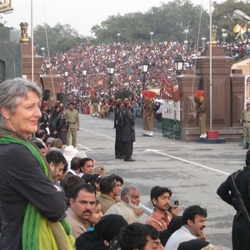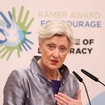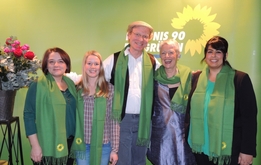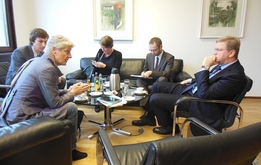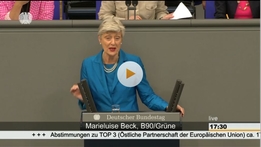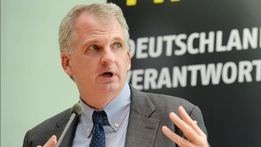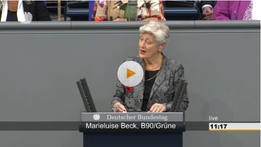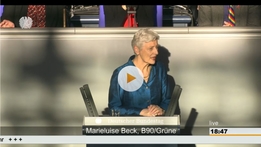A Country on the Edge - Anyone travelling to Pakistan with its national airline soon gains an impression of the real situation in the country: without massive financial support from outside, Pakistan would have been finished long ago. ‘Please Inform Allah’ – this tongue-in-cheek translation of the acronym for Pakistan International Airlines (PIA) conceals sometimes benign and sometimes alarming truths.
Pakistan is a country with a population of 165 million and only five million taxpayers, but with a military apparatus comprising 600,000 troops. It is a country whose citizens are accustomed to being exploited – sometimes by the ruling oligarchies, sometimes by the bureaucracy, sometimes by the military. It is a country which has long been embroiled in civil war, and where religious-totalitarian structures are eating ever more deeply into the fabric of society. And it is a nuclear power – one which operates outside the controls imposed by the Non-Proliferation Treaty. For the time being, the semi-secular military still holds the key to the nuclear arsenal. However, the military too is changing in nature. The up-and-coming generation of officers has not remained untouched by the country’s Islamization.
So is Pakistan really ‘the world’s most dangerous country’? What is certain is that Pakistan is at great risk from the threat of state failure, and that there is great potential for violence both within the country itself and towards the outside world.
After the subcontinent’s partition into Muslim Pakistan and the mainly Hindu India, Pakistan never really found peace. To its west lies Afghanistan, separated by a colonial border which cuts through Pashtun tribal lands and has never been recognised by Afghanistan or Pakistan. To the east is Pakistan’s ‘arch enemy’ India, which controls the part of Kashmir – and its majority Muslim population – under its administration with a firm hand. Destabilizing Indian control over Kashmir is an unofficial but rigorously pursued objective of the Pakistani military and intelligence service.
In addition to external conflicts, Pakistan has its own internal tensions. In the western part of the country are the tribal areas which operate outside the control of central government and Pakistani law . With their archaic tribal structures and customs, these areas are ignored by the leaders in Islamabad. They are ideal refuges for ‘Allah’s warriors’ from numerous countries, who have bedded down in the border areas between Afghanistan and Pakistan.
At one time, Pakistan adhered to a sufi – a spiritual and tolerant – Islamic tradition. However, radical Islamist sects originating in India have been utilized by successive civilian and military governments in Pakistan in order to create an Islamic raison d’état and incite enemy images within Pakistan and outside in a bid to stabilize their own authority.
This background goes some way towards explaining why Pakistan is a country where conspiracy theories and enemy images abound: the Afghans are determined to destroy Pakistan, the Indians want to overrun it, the Shi’ites are bent on driving it to religious ruin, the Americans want to infiltrate it, and – not to be left out of the equation – the Jews want to tear Pakistan apart, to cite just a few examples.
Conspiracy thinking not only influences the ordinary people in Pakistan; it is also endemic in the military and to some extent among the well-educated middle class. The relationship with the USA in particular is paradoxical: on the one hand, the state – including the military – is heavily dependent on US financial aid, but on the other, there is Pakistan’s notorious anti-Americanism.
Anyone wishing to work out why the country is hurtling towards its own destruction at breakneck speed needs to understand the historical baggage, which goes back a long way and continues to dominate present-day Pakistani politics and society.
The collective fear of state failure and the end of Pakistan’s national existence is deep-rooted in Pakistani society, politics and the military. The enemy is always elsewhere – in Afghanistan, India, the USA or Israel. These enemy images relieve Pakistan’s ruling elites – who shamelessly exploit their country – of any need to engage in critical self-reflection, and prepare the ground for many different forms of extremism. In radical Islam, religion and politics merge to form a totalitarian system that exerts complete control over the individual; numerous religious schools ( madrassas ) turn millions of children and young people into religious fanatics and political extremists. These young people will not grow up to work for a living. ‘You love life, we love death’: the fight against the ‘godless West’ – and against the secular parts of their own society – is inculcated into these young women and men, with devastating consequences. Their fight has already begun – and the bombings that occur throughout Pakistan every day are the proof. Already, the death toll from these attacks in Pakistan outstrips casualty numbers in Afghanistan.
The war in Afghanistan and its impacts on Pakistan
In the discussion with Dr. Ahmed Khan , Director of the Institute of Strategic Studies, it immediately became apparent that Pakistan’s internal development and security situation cannot be considered in isolation from Afghanistan. His assessment of the situation in Afghanistan was ruthless in its honesty.
The Petersberg Process, said Dr. Ahmed Khan, was characterized by naivety. The war in Afghanistan is now in its ninth year, the country still has no statehood, and the institutions that do exist are corrupt and inefficient. President Karzai has collaborated with warlords and criminals, which has greatly impeded the reconstruction process. After 30 years of conflict and civil war, Afghanistan is an extremely fragmented society.
Dealing with Afghanistan in terms of whether the war there can be ‘won’ is fundamentally the wrong approach. Obama should be thinking in terms of stabilizing the country, which means building local networks and also reaching out to members of the Taliban who are politically aware and willing to negotiate. However, it is important to bear in mind that members of the Taliban who might agree to cooperate are putting themselves at great risk because they could be accused of collaboration, and that some Taliban can never be won over.
For Pakistan, the issue of the withdrawal of Western troops from Afghanistan is a matter of life or death. A hasty withdrawal would be disastrous.
Unlike the Taliban in Afghanistan, who can claim to be taking action against ‘occupation by the West’, the Taliban in Pakistan are now seen as destroyers of the state. There is a growing determination in Pakistan to rid the country of these destructive militants, who are willing to use extreme violence against the Pakistani people.
At the Ministry of Foreign Affairs , too, the close linkage between developments in Pakistan and Afghanistan was emphasised. According to the Foreign Secretary, the West’s defeat or failure in Afghanistan would have spillover effects beyond Afghanistan’s borders. Back in 1988, the overhasty withdrawal of Soviet troops left a vacuum, with the result that five million Afghan refugees fled to Pakistan. Another overhasty withdrawal would lead to a repetition of this crisis.
Asfand Yar Wali Khan – the son of a respected tribal elder, Chairman of the Standing Committee on Foreign Affairs, and President of the Awami National Party (ANP), one of Pakistan’s secular parties – emphasised that the ANP had greatly welcomed the West’s intervention in Afghanistan, for otherwise, Afghanistan would have become an Arab colony. The fact is that Pakistan has trained militants for jihad in Afghanistan as well as militants for deployment in Kashmir, and there is also a large group of militants from Uzbekistan, Chechnya and the Arab countries in the region.
The Taliban, he said, cannot invoke Islam, for anyone who kills civilians, fails to unequivocally condemn suicide attacks and bombs a women's canteen, as recently occurred in Islamabad, shows no devotion whatsoever to God.
In the western areas of Pakistan, there is little difference nowadays between the Taliban and Al-Qaeda. The warlord Gulbuddin Hekmatyar, for example, has turned the western areas of Pakistan into a ‘safe haven’ for Al-Qaeda fighters, who can now resume operations from here.
In February 2009, the ANP struck a deal with the Taliban in the tribal areas: a ceasefire in exchange for the introduction of sharia law. Asfand Yar Wali Khan himself pushed the deal through in the face of opposition from the government. The militants never adhered to the agreement – evidence that the Taliban are not interested in compromise. Their destruction of more than 200 girls’ schools has also met with opposition from the tribes themselves – for although they are extremely conservative, they still want their daughters to learn to read and write so that they have a future.
The tribes are now determined not to allow the militants to take control of the tribal areas and the border regions in the north-west. Joint action is now taking place, involving the Pakistani army and the tribal elders, who are setting up their own village defence forces. Afghanistan’s development, too, must be put in the hands of its own people. Asfand Yar Wali Khan made it very clear that Pakistan has no future if the Taliban are allowed to win in Afghanistan. Taking his leave, he left us to ponder on an anecdote: ‘When my grandmother married my grandfather, it was a mistake – but when she left him, it was a bigger one.’
The Islamization of every-day life in Pakistan
Samar Minallah , a young film-maker from a highly respected Pakistani family, was already known to me from the Western media. In early April, she had sent video footage recorded on a phone camera to the Pakistani media. It showed the public flogging of a 17-year-old girl who had rejected a marriage proposal from a member of the Taliban. Samar Minallah’s determination and great courage in opposing such barbaric violence against women is impressive. The horrifying scene was broadcast on all the private TV channels in Pakistan. At the same time, the courageous film-maker was condemned for sabotaging a peace deal with the Taliban. (Anyone who can bear to watch the video can access it by googling ‘Taliban flog girl, 17, as she begs for mercy in 'honour' punishment’.)
In Pakistan, there are a great many well-educated and self-confident women who take an active role in society. The issues of concern to them are the same as those preoccupying women’s initiatives all over the world: domestic violence; early marriage of young girls, i.e. children, under the age of 16; sexual assault; and women’s exclusion from education and employment.
Dr. Marie Lall , a German-French-British professor who teaches in both the UK and Pakistan, gave a very impressive account of a madrassa for girls to which, after a long wait, she was finally given access. Dr. Lall explained that around 100 young women are boarders at the school, which also has 250 external students. Although it is customary for women to take off their burqas when they are together in private, the young women remained veiled during Dr. Lall’s visit. Male madrassa students were also present, separated from the women by a curtain. Only the men spoke to her, as the young women must not allow their voices to be heard by the young men.
There are now hundreds of these madrassas , not only in the areas along Pakistan’s western border but also in the interior of the country. Dr. Lall believes that Pakistan’s middle class is systematically disregarding this phenomenon and the resulting changes in society. Islamization at the heart of Pakistan has progressed much further than leading sections of society are prepared to acknowledge.
This impression was supported by the very powerful report by Prof. Dr. Pervez Amirali Hoodbhoy , a professor of physics and critic of nuclear weapons. He showed us around the campus of Quaid-i-Azam University in Islamabad, where there are now very few young women who do not wear a hijab or veil. The situation was very different 20 years ago, said the Professor. Absurdly, the fundamentalists and the political left coincide in their assessment of the USA: one side sees America as a hotbed of vice that violates the morality prescribed by religion; the other blames US influence for the state of the country, its corrupt middle classes and the power of the military. Western-oriented secular individuals such as Prof. Hoodbhoy who are immune to conspiracy theories and rabid nationalism appear to be increasingly isolated in Pakistan.
He showed us photographs showing the curriculum of a madrassa : the alphabet is taught using pictures which incite the young people to jihad. In a country where some 40 million young men are growing up with no prospect of future employment and hence a family life, it does not take much imagination to see the burgeoning potential for fanaticism here.
